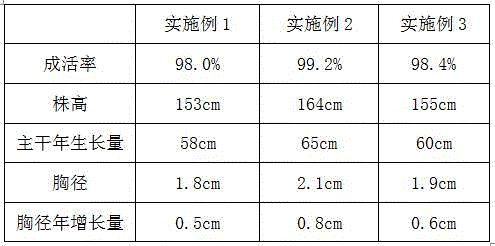Method for collecting rainwater by adopting water storage layer containing diatomite and application thereof in saline-alkali soil improvement
A technology for collecting rainwater and aquifers, applied in application, land preparation methods, drinking water devices, etc., can solve the problem of poor pH, salinity, bulk density and water content improvement in saline-alkali land, no improvement in soil water storage capacity, and saline-alkali land fertility. Improve insignificant problems, to reduce soil erosion, improve water storage capacity, save freshwater resources and fertilizers
- Summary
- Abstract
- Description
- Claims
- Application Information
AI Technical Summary
Problems solved by technology
Method used
Image
Examples
Embodiment 1
[0034] Example 1 A method of collecting rainwater using an aquifer containing diatomite
[0035] Step 1 deep plowing
[0036] Before planting, plow the land 60-65cm deep, break up the soil clods, and rake them finely.
[0037] Step 2 Excavate the original soil
[0038] Dig out the original soil in the planting area, the excavation depth is 90-100cm, after digging out the original soil, compact the bottom.
[0039] Step 3 laying the aquifer
[0040] Lay a fine sand layer at the bottom of the soil tank after the original soil is excavated, the thickness of the fine sand layer is 10cm, and the particle size of the fine sand is 2-2.5mm.
[0041] Lay the aquifer above the fine sand layer, the thickness of the aquifer is 40cm, and the raw material of the aquifer, in parts by weight, includes the following components:
[0042] 24 parts of diatomite, 30 parts of ceramsite, 3 parts of water-absorbing stone, 15 parts of asbestos powder, 4.5 parts of cotton seed hulls, 7 parts of Oph...
Embodiment 2
[0051] Example 2 A method of collecting rainwater using an aquifer containing diatomite
[0052] Carry out according to the method for embodiment 1, only change " laying aquifer " step, carry out embodiment 2; " laying aquifer " step of embodiment 2:
[0053] Lay a fine sand layer at the bottom of the soil tank after the original soil is excavated, the thickness of the fine sand layer is 10cm, and the particle size of the fine sand is 2-2.5mm.
[0054] Lay the aquifer above the fine sand layer, the aquifer thickness is 45cm, the raw material of the aquifer, in parts by weight, includes the following components:
[0055] 26 parts of diatomite, 38 parts of ceramsite, 5 parts of water-absorbing stone, 18 parts of asbestos powder, 5.5 parts of cotton seed hulls, 9 parts of Ophiopogon japonicus powder, 3 parts of elm bark powder, 7 parts of high-substitution cross-linked carboxymethyl cellulose , 3 parts of walnut shell powder, 2 parts of furnace ash;
[0056] The diatomite: the ...
Embodiment 3
[0061] Example 3 A method of collecting rainwater using an aquifer containing diatomite
[0062] Carry out according to the method for embodiment 1, only change " laying aquifer " step, carry out embodiment 3; The " laying aquifer " step of embodiment 3:
[0063] Lay a fine sand layer at the bottom of the soil tank after the original soil is excavated, the thickness of the fine sand layer is 10cm, and the particle size of the fine sand is 2-2.5mm.
[0064] Lay the aquifer above the fine sand layer, the thickness of the aquifer is 50cm, and the raw material of the aquifer, in parts by weight, includes the following components:
[0065] 28 parts of diatomite, 42 parts of ceramsite, 7 parts of water-absorbing stone, 20 parts of asbestos powder, 7.5 parts of cotton seed hulls, 11 parts of Ophiopogon japonicus powder, 4 parts of elm bark powder, 8 parts of high-substitution cross-linked carboxymethyl cellulose , 4 parts of walnut shell powder, 3 parts of furnace ash;
[0066] The d...
PUM
 Login to View More
Login to View More Abstract
Description
Claims
Application Information
 Login to View More
Login to View More - R&D
- Intellectual Property
- Life Sciences
- Materials
- Tech Scout
- Unparalleled Data Quality
- Higher Quality Content
- 60% Fewer Hallucinations
Browse by: Latest US Patents, China's latest patents, Technical Efficacy Thesaurus, Application Domain, Technology Topic, Popular Technical Reports.
© 2025 PatSnap. All rights reserved.Legal|Privacy policy|Modern Slavery Act Transparency Statement|Sitemap|About US| Contact US: help@patsnap.com


